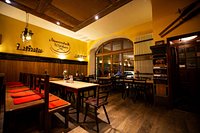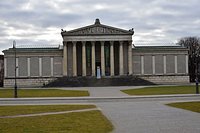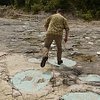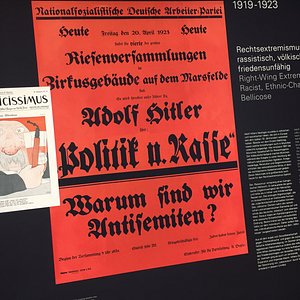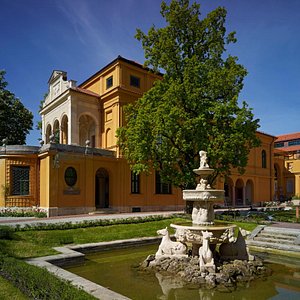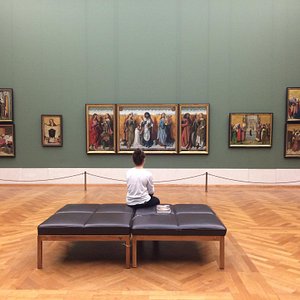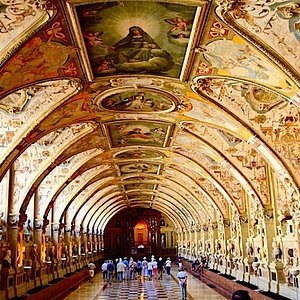Glyptothek
Glyptothek
4.5
About
Glyptothek is temporarily closed. Scheduled to reopen on October 13, 2020. Excellent collection of antique sculptures.
Suggest edits to improve what we show.
Improve this listingTours & experiences
Explore different ways to experience this place.
Full view



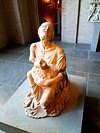
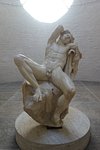





Top ways to experience Glyptothek and nearby attractions
The area
Address
How to get there
- Königsplatz • 3 min walk
- Theresienstraße • 8 min walk
Reach out directly
Best nearby
Restaurants
3,207 within 3 miles
Attractions
465 within 6 miles
Contribute
Most Recent: Reviews ordered by most recent publish date in descending order.
Detailed Reviews: Reviews ordered by recency and descriptiveness of user-identified themes such as wait time, length of visit, general tips, and location information.
Popular mentions
4.5
383 reviews
Excellent
214
Very good
117
Average
37
Poor
8
Terrible
7
Thomas A
Munich, Germany66 contributions
Jul 2021
I visited here alone on a weekday and had a great time. I recently moved here, and my German isn't great yet, and was surprised that the museums staff didn't speak more English - it was a bit of a struggle to get my ticket. This said, the museum was excellent. It is almost entirely sculpture, but of the highest quality, and most ancient variety. Very well displayed, and interpreted, I got some really good photographs. I would thoroughly recommend
Written July 15, 2021
This review is the subjective opinion of a Tripadvisor member and not of Tripadvisor LLC. Tripadvisor performs checks on reviews as part of our industry-leading trust & safety standards. Read our transparency report to learn more.
macedonboy
Glasgow, UK179,824 contributions
Jun 2019 • Solo
As others have mentioned already, the Glyptothek is current closed for renovations and will not be open again until 2021. I just wish the website mentioned it. Had it not been for the Propylaea and the Staatliche Antikensammlungen museum opposite Glyptothek, the day would've been a total loss.
The entirety of the building is covered up during the renovations. At best, you can see the roof from the steps of Staatliche Antikensammlungen.
The entirety of the building is covered up during the renovations. At best, you can see the roof from the steps of Staatliche Antikensammlungen.
Written June 5, 2019
This review is the subjective opinion of a Tripadvisor member and not of Tripadvisor LLC. Tripadvisor performs checks on reviews as part of our industry-leading trust & safety standards. Read our transparency report to learn more.
MirugaiT
San Francisco, California, United States2 contributions
Sep 2012 • Couples
Philosophies of restoration are exemplified and explored in this wonderful project. Best place in Munich for art, archeology, history and philosophy fans.
Written September 24, 2012
This review is the subjective opinion of a Tripadvisor member and not of Tripadvisor LLC. Tripadvisor performs checks on reviews as part of our industry-leading trust & safety standards. Read our transparency report to learn more.
BennyMalaga
Malaga, Spain89,775 contributions
Jul 2012 • Couples
The Glyptothek was built between 1816 and 1830 by the architect Leo von Klenze, using the plans of Carl von Fischer. The building has the Ionic style and has a collection of 160 classical sculptures. There are 13 rooms around the courtyard. Among the sculptures are those from the pediment of the Temple of Aegina that was excavated in 1811. One masterpiece is the Barberini Faun, which shows a slepping satyr. This dates to 220 B.C. This is a masterpiece of Greek sculpture that was brought to Rome. The Alexander Rondanini is a Roman sculpture that is a portrait of Alexander the Great and dates to about 340 B.C. A very good sculpture is that of Augustus Caesar. The Boy with the Goose is also a very good sculpture. The floor mosaic from a Roman villa is very good.
Written July 20, 2012
This review is the subjective opinion of a Tripadvisor member and not of Tripadvisor LLC. Tripadvisor performs checks on reviews as part of our industry-leading trust & safety standards. Read our transparency report to learn more.
Leo_0031
NL209 contributions
Feb 2017 • Couples
The Glyptothek, situated at the Königsplatz, holds a collection of Greek and Roman sculptures dating from about 700 BC until about 550 AD.
Of course it’s interesting to watch the ancient art by itself, but for a better understanding and appreciation of these beautiful sculptures my advice is to either ask for the media guide at the desk or download the app in advance (available for both Android and I-Phone).
Since there are no extensive explanatory texts to the sculptures themselves you will have a better understanding of what you are looking at while listening to the additional information on your headphone and still be able to walk around the sculptures at the same time.
In each room you will find plastic cards with some information, but the audioguide and the app will tell you a lot more on these wonderful old works of art.
The media guide at the museum is well worth its money (4 euro). The other option is to download the free app at home in either German or English language version.
If you want to watch the Glyptothek with minimal costs, then plan your visit on Sunday. Regular entrance fee is 6 euro, but on Sundays the Glyptothek and several other art museums nearby can be visited for the reduced price of 1 euro each.
Opening times: Tue, Wed, Fri-Sun 10 am – 5 pm, on Thursdays evenings until 8 pm.
Beware: the Glyptothek, like most other Munich museums is closed on Mondays.
How to get there easily with the public transport system: at the Hauptbahnhof (central train station) take the U2 subway towards Feldmoching and get out at the first stop (Königsplatz). When getting out of the subway station you’ll see the classic Glyptothek building at about 150 meters. A second possibility is to take Bus 100 (the so called “museumline” travelling between Hauptbahnhof and Ostbahnhof) and get off at the Königsplatz.
Without using public transport, walking from the Hauptbahnhof to the Glyptothek will take you some 10 minutes.
Not to be missed, no matter how much time you are willing to spend: the world famous Barberini Faun, the Munich and the Tenea Kouros, the Medusa Rondanini and the Aphaia temple figures.
Time needed depends on how far your curiosity stretches. The short version (13 highlights) on the media guide will take a little over an hour. If you like to do the “connoisseur tour “ you may well exceed four hours! There’s also a third tour called “The Greek idea of man” which focuses on the development of Greek sculpture from 6th to 1st century BC.
Either which way you decide, you’re free to walk around as you like and you’re allowed to make pictures, provided you don’t make use of a tripod and don’t publish your pictures commercially.
We visited on a Sunday and together with a stop at the Museum Café (drinks and small snacks) which is situated about half the way into the museum, my wife and I spent almost two and a half hours at the Glyptothek. Which was about an hour more than we had expected...
Of course it’s interesting to watch the ancient art by itself, but for a better understanding and appreciation of these beautiful sculptures my advice is to either ask for the media guide at the desk or download the app in advance (available for both Android and I-Phone).
Since there are no extensive explanatory texts to the sculptures themselves you will have a better understanding of what you are looking at while listening to the additional information on your headphone and still be able to walk around the sculptures at the same time.
In each room you will find plastic cards with some information, but the audioguide and the app will tell you a lot more on these wonderful old works of art.
The media guide at the museum is well worth its money (4 euro). The other option is to download the free app at home in either German or English language version.
If you want to watch the Glyptothek with minimal costs, then plan your visit on Sunday. Regular entrance fee is 6 euro, but on Sundays the Glyptothek and several other art museums nearby can be visited for the reduced price of 1 euro each.
Opening times: Tue, Wed, Fri-Sun 10 am – 5 pm, on Thursdays evenings until 8 pm.
Beware: the Glyptothek, like most other Munich museums is closed on Mondays.
How to get there easily with the public transport system: at the Hauptbahnhof (central train station) take the U2 subway towards Feldmoching and get out at the first stop (Königsplatz). When getting out of the subway station you’ll see the classic Glyptothek building at about 150 meters. A second possibility is to take Bus 100 (the so called “museumline” travelling between Hauptbahnhof and Ostbahnhof) and get off at the Königsplatz.
Without using public transport, walking from the Hauptbahnhof to the Glyptothek will take you some 10 minutes.
Not to be missed, no matter how much time you are willing to spend: the world famous Barberini Faun, the Munich and the Tenea Kouros, the Medusa Rondanini and the Aphaia temple figures.
Time needed depends on how far your curiosity stretches. The short version (13 highlights) on the media guide will take a little over an hour. If you like to do the “connoisseur tour “ you may well exceed four hours! There’s also a third tour called “The Greek idea of man” which focuses on the development of Greek sculpture from 6th to 1st century BC.
Either which way you decide, you’re free to walk around as you like and you’re allowed to make pictures, provided you don’t make use of a tripod and don’t publish your pictures commercially.
We visited on a Sunday and together with a stop at the Museum Café (drinks and small snacks) which is situated about half the way into the museum, my wife and I spent almost two and a half hours at the Glyptothek. Which was about an hour more than we had expected...
Written March 8, 2017
This review is the subjective opinion of a Tripadvisor member and not of Tripadvisor LLC. Tripadvisor performs checks on reviews as part of our industry-leading trust & safety standards. Read our transparency report to learn more.
CJT007
London, UK373 contributions
Oct 2013 • Couples
This museum, in the Museum District, contains probably the world's finest collection of Greek and Roman antique sculptures. It is immaculately laid out with plenty of space around the exhibits to see them from all angles and in close up. The entrance fee gets you a superb guide book describing all the exhibits in English with photographs of each. If you like antique sculpture or have just a passing interest I highly recommend this museum.
Written November 22, 2013
This review is the subjective opinion of a Tripadvisor member and not of Tripadvisor LLC. Tripadvisor performs checks on reviews as part of our industry-leading trust & safety standards. Read our transparency report to learn more.
twyss
Zurich, Switzerland237 contributions
Apr 2013 • Friends
My art history teacher once told me that if I'm ever in Munich I should go see the Glyptothek exhibition, and so I did on my first Munich visit.
I'm not much of a museum freak but this place is beautiful & worth seeing. The greek and roman sculptures are arranged beautifully in the light flooded halls in a spacious way.
The museum is not huge, an hour will be sufficient for most visitors, maybe more for experts or those who read all of the descriptions about the artwork.
There's a nice little cafe half way through the museum.
On sunday's the entrance is only 1 euro.
I'm not much of a museum freak but this place is beautiful & worth seeing. The greek and roman sculptures are arranged beautifully in the light flooded halls in a spacious way.
The museum is not huge, an hour will be sufficient for most visitors, maybe more for experts or those who read all of the descriptions about the artwork.
There's a nice little cafe half way through the museum.
On sunday's the entrance is only 1 euro.
Written April 8, 2013
This review is the subjective opinion of a Tripadvisor member and not of Tripadvisor LLC. Tripadvisor performs checks on reviews as part of our industry-leading trust & safety standards. Read our transparency report to learn more.
joemY3087XB
100 contributions
Oct 2018 • Couples
This museum is not the largest but is well layed out and presented to the public. There are a lot of busts and the majority of sculptures are from Greece. If you have a hour to spare and like Greek sculpture, definitely go. Your ticket does allow you to go to museum across the street as well.
Written October 26, 2018
This review is the subjective opinion of a Tripadvisor member and not of Tripadvisor LLC. Tripadvisor performs checks on reviews as part of our industry-leading trust & safety standards. Read our transparency report to learn more.
oborozuki
San Carlos, CA190 contributions
Nov 2017 • Friends
Several years back, my wife and I took a short one day cruise to three Greek islands: Hydra, Poros, and Aegina. On the boat trip we met a fascinating German archeologist, Maria Schütze from Munich who was having a kind of farewell visit to the many sites in Greece which had figured in her long career. One of these was the Island of Aegina. It is on Aegina where the famous, Doric temple of Aphaia resides on a hill overlooking the Saronic Gulf with Salamis and the port of Piraeus to the north and Athens slightly north east where one can see, on a clear day, the acropolis, while to the east lies Sounion and the Temple of Poseidon—this is the so-called “Sacred Triangle” or “Antiquity’s Perfect Triangle.” The oldest of these temples is the Temple dedicated to a pre-Hellenic deity Aphaia, so called because she “vanished” when pursued by King Minos of Crete. The temple dates from the late Archaic period (circa 500 BC) and is thought to have been, because of its architectural refinements in proportion and the inclination of its columns, a model for the Parthenon. This temple is the only known site of the worship of the goddess Aphaia. A visit to this magical place was among the highlights of our visit to Greece. It was here where Maria told us that if we ever came to Munich, she would accompany us to the Glyptothek where the pediment sculptures from this ancient temple are on display, depicting scenes from the Trojan wars. And, indeed, one of the great beauties of the Glyptothek is the display of these sculptures and piecing together what we had seen several years earlier on the island of Aegina, and particularly, with Maria’s expert guidance. These pedimental sculptures, according to the Glyptothek’s website, are said to be the most important surviving monuments of Greek art, as they mark the precise boundaries between two important periods of Greek art—the late archaic of the west pediment, and the early classical of the east pediment. But there are other outstanding works to be seen at the Glyptothek such as the emotive “Barberini faun,” the wonderful “Boy with a goose” the bronze statuette of the goddess of beauty from 100 BC with its strikingly modern look and appeal. If you are interested in antique sculpture this is the only museum in the world solely dedicated to antique sculpture. All of this is housed in one of the most significant architectural structures in Munich built between 1816 and 1830 for King Ludwig I when he was Crown Prince Ludwig. Even if you do not have Maria as your guide, you’ll enjoy this beautiful museum with its outstanding collection.
Written December 13, 2017
This review is the subjective opinion of a Tripadvisor member and not of Tripadvisor LLC. Tripadvisor performs checks on reviews as part of our industry-leading trust & safety standards. Read our transparency report to learn more.
Alyson M
London, UK8 contributions
Jun 2013 • Couples
This is a relatively small museum housing the Greek and Roman sculptures of the Bavarian King Ludwig I. The collection includes the outstanding Barberini Faun popularly known as the 'Drunken Satyr' (which is worth a visit on its own). The previously ornate interior was destroyed as a result of action during the Second World War. The restoration resulted in a very much simplified interior. It is this paired down space, as well as the quality of the pieces that makes a visit so enjoyable. The plain brick walls present a perfect backdrop against which the cool marble stands. Pictures taken without flash are allowed.
Written June 13, 2013
This review is the subjective opinion of a Tripadvisor member and not of Tripadvisor LLC. Tripadvisor performs checks on reviews as part of our industry-leading trust & safety standards. Read our transparency report to learn more.
Earl Bothwell
2 contributions
I understand the Glyptothek is now closed, but I'm wondering if any of the masterpieces have been moved to another location, so that one might still view them? It would be rather ridiculous not to make any of them accessible to the public for several years while the building is renovated!
Keith O
Erding, Germany34 contributions
Is it allowed to take photographs inside the Glyptothek, only for personal use?
canuckshutterbug
Toulon, France1,688 contributions
As usual in most museums, they discourage flash and if you're taking pics of anything you shouldn't be, there will be somebody there to remind you. We had no problem taking all the pics we wanted.
Is this your Tripadvisor listing?
Own or manage this property? Claim your listing for free to respond to reviews, update your profile and much more.
Claim your listingGlyptothek - All You Need to Know BEFORE You Go (2024)
Frequently Asked Questions about Glyptothek
- According to Tripadvisor travelers, these are the best ways to experience Glyptothek:
- Munich City Hop-on Hop-off Tour (From $26.17)
- Munich Private Tours with Locals: 100% Personalized, See the City Unscripted (From $238.98)
- Visit the Collection of Greek Statues (Glyptothek) in Munich with Paul (From $103.60)
- Munich Card with public transport: Save at attractions & tours! (From $23.88)
- Munich Card (Group) with public transport: Save at attractions & tours! (From $47.44)
- Hotels near Glyptothek:
- (0.26 mi) The Charles Hotel
- (0.29 mi) Ruby Lilly Hotel Munich
- (0.32 mi) King's Hotel First
- (0.18 mi) Marienbad
- (0.33 mi) AdvaStay by KING's
- Restaurants near Glyptothek:
- (0.09 mi) ELLA Restaurant
- (0.05 mi) Cafe Glyptothek
- (0.20 mi) Hamburgerei
- (0.20 mi) Mr. Pancake
- (0.15 mi) Restaurant JAN - Jan Hartwig

























